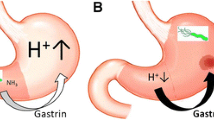Abstract
We investigated if hypergastrinemia exerted any influence on the proliferation of gastroduodenal epithelium during the healing of ulcers in rats. A mucosal ulcer was induced in the corpus region of the stomach in three groups of rats, which were then given vehicle, omeprazole (400 μmol/kg/day), or gastrin-17 (60 nmol/kg/day) for three or six days. A fourth group of unoperated rats served as controls. One hour before killing, [3H]thymidine was injected. The ulcer margin and corresponding control tissues were excised and processed for light microscopic determination of epithelial labeling index (LI), mitotic index, and apoptotic index. LI was also determined in other parts of the gastroduodenal mucosa. Three and six days after the ulcer operation, the LI in the vehicle-treated ulcer rats was significantly increased in the ulcer margin and in the duodenum, in comparison with the intact controls. In the ulcer margin, the mitotic index was significantly increased, in parallel with the LI; the apoptotic index remained at the control level. The LI in the ulcer margin was increased further after administration of omeprazole or gastrin-17, which elevated the plasma gastrin levels by 5–15 times. It is concluded that hypergastrinemia may increase cell proliferation in the ulcer margin, which may accelerate the rate of healing.
Similar content being viewed by others
References
Helpap B, Hattori T, Gedigk P: Repair of gastric ulcer. A cell kinetic study. Virchows Arch (Pathol Anat) 392:159–170, 1981
Helander HF: Morphological studies on the margin of gastric corpus wounds in the rat. J Submicrosc Cytol 15(3):627–643, 1983
Okuhira M, Nakano T, Kitajima T, Maruoka M, Hiramatsu A, Mizuno T, Inoue K: Cell proliferation kinetics in the marginal mucosa of gastric ulcer evaluated by immunostaining of DNA polymerase. Digestion 48:185–191, 1991
Wright NA, Pike CM, Elia G: Ulceration induces a novel epidermal growth factor-secreting cell lineage in human gastrointestinal mucosa. Digestion 46(suppl 2):125–133, 1990
Lee H, Hansson HA, Norström E, Helander HF: Immunoreactivities for epidermal growth factor (EGF) and for EGF receptors in rats with gastric ulcers. Cell Tissue Res 265:211–218, 1991
Tarnawski A, Stachura J, Durbin T, Sarfeh IJ, Gergely H: Increased expression of epidermal growth factor receptor during gastric ulcer healing. Gastroenterology 102:695–698, 1992
Konturek SJ, Brzozowski T, Majka J, Dembinski A, Slomiany A, Slomiany BL: Transforming growth factor alpha and epidermal growth factor in protection and healing of gastric mucosal injury. Scand J Gastroenterol 27:649–655, 1992
Fitzpatrick LR, Jakubowska A, Martin GE, Davis M, Jaye MC, Dionne CA: Acidic fibroblast growth factor accelerates the healing of acetic-acid-induced gastric ulcers in rats. Digestion 53:17–27, 1992
Nakamura M, Oda M, Inoue J, Ito T, Tsuchiya M: Interaction of fibroblast growth factor to the myofibroblast induced by acetic acid-induced ulcer. Gastroenterology 100:A131, 1991
Hansson HA, Norström E: aFGF, EGF and their receptors in the normal and healing rat gastric mucosa. Digestion 49(suppl 1):17–18, 1991
Håkanson R, Sundler F: Trophic effects of gastrin. Scand J Gastroenterol 26(suppl 180):130–136, 1991
Ryberg B, Tielemans Y, Axelson J, Carlsson E, Håkanson R, Mattsson H, Sundler F, Willems G: Gastrin stimulates the self replication rate of the enterochromaffin-like cells in the rat stomach. Gastroenterology 99:935–942, 1990
Johnson LR: Regulation of gastrointestinal growth:In LR Johnson. (ed). Physiology of the Gastrointestinal Tract, Vol 1. 2nd ed. New York: Raven Press, 1987, pp 301–333
Allen A, Flemström G, Garner A, Kivilaakso E: Gastroduodenal mucosal protection. Physiol Rev 73:823–857, 1993
Tielemans Y, Håkanson R, Sundler F, Willems G: Proliferation of enterochromaffinlike cells in omeprazole-treated hypergastrinemic rats. Gastroenterology 96:723–729, 1989
Håkanson R, Axelson J, Tielemans Y, Johansson AG, Willems G, Sundler F: Unilateral vagal denervation suppresses omeprazole-induced trophic effects on the denervated side of the rat stomach. Scand J Gastroenterol 27:65–70, 1992
Schaudies RP, Grimes J, Davis D, Rao RK, Koldovsky O: EGF content in the gastrointestinal tract of rats: Effect of age and fasting/feeding. Am J Physiol 256 (Gastrointest Liver Physiol 19):G856-G861, 1989
Author information
Authors and Affiliations
Rights and permissions
About this article
Cite this article
Li, H., Helander, H.F. Hypergastrinemia increases proliferation of gastroduodenal epithelium during gastric ulcer healing in rats. Digest Dis Sci 41, 40–48 (1996). https://doi.org/10.1007/BF02208582
Received:
Revised:
Accepted:
Issue Date:
DOI: https://doi.org/10.1007/BF02208582



